Concord, NH Pollen and Allergy Report for Summer 2023
Pollen Allergy Trends in Concord, NH
When is pollen lowest in Concord, NH?

February
Lowest month total PPM
Avg. PPM
When is pollen highest in Concord, NH?

April
Highest month total PPM
Avg. PPM
How does pollen in Concord, NH compare to New Hampshire?
Concord has a lower average PPM than the state of New Hampshire.
Concord yearly avg PPM:
New Hampshire yearly avg PPM:
How does pollen in Concord, NH compare to the USA?
Concord has a higher average PPM than the USA.
Concord yearly avg PPM:
USA yearly avg PPM:
Is pollen worse this year in Concord, NH?
Spring 2023 was worse than spring 2022.
Spring 2023 PPM:
Spring 2022 PPM:
Average PPM in Concord, NH

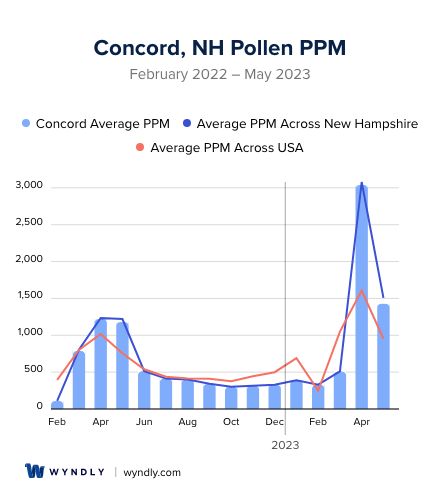
Concord, NH Pollen and Allergy Breakdown by Month
Grass
When is grass pollen highest in Concord, NH?
April has the highest grass pollen in Concord, NH with an average PPM of
When is grass pollen lowest in Concord, NH?
December has the lowest grass pollen in Concord, NH with an average PPM of
Tree
When is tree pollen highest in Concord, NH?
April has the highest tree pollen in Concord, NH with an average PPM of
When is tree pollen lowest in Concord, NH?
October has the lowest tree pollen in Concord, NH with an average PPM of
Weed
When is weed pollen highest in Concord, NH?
April has the highest weed pollen in Concord, NH with an average PPM of
When is weed pollen lowest in Concord, NH?
February has the lowest weed pollen in Concord, NH with an average PPM of
Concord, NH Pollen Monthly Breakdown by Pollen Type
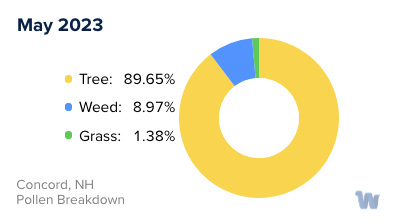
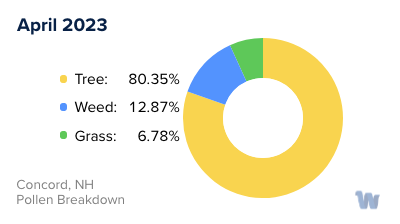
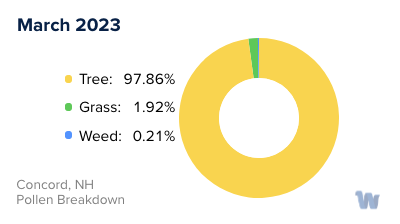

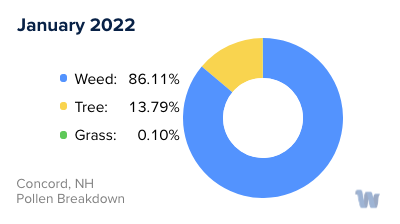
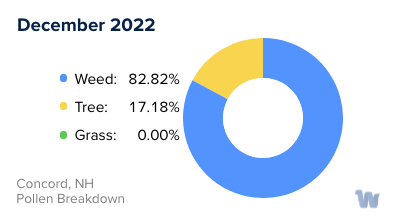






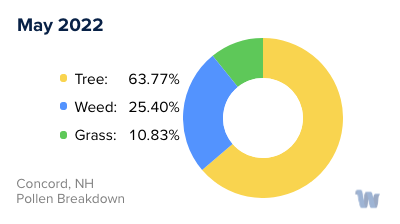

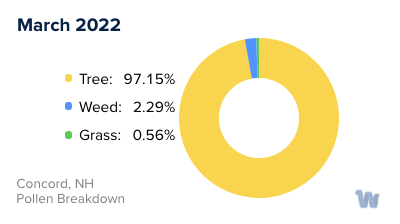

Pollen and Hay Fever in Concord, NH
For residents and visitors of Concord, New Hampshire, pollen allergies and hay fever can be a fact of life. New Hampshire, known for its quaint towns and majestic wilderness, experiences all four seasons, each bringing its unique set of pollen allergens. This cycle can cause seasonal allergies to flare up at different times of the year due to varying pollen sources.
In New Hampshire, the pollen season starts with the advent of spring. After the chill of winter, pollen allergies commonly begin to emerge in late February. However, if the winter season is milder than usual, allergy season can make an earlier appearance.
During spring, the primary culprit for allergies is tree pollen. As trees awaken from their winter slumber, they release pollen into the air, causing an increase in allergy symptoms. Common trees in New Hampshire that contribute to springtime allergies include willow, hickory, poplar, oak, and cedar.
As the weather warms and summer arrives, the source of pollen allergies transitions from trees to grasses. Residents may notice an increase in their allergy symptoms due to grass pollens such as ryegrass, sweet vernal grass, and orchard grass.
The arrival of fall signals a shift in pollen sources once again. In this season, it's the weeds that are predominantly responsible for triggering allergies. Ragweed, wormwood, and amaranth are some common weed pollens in New Hampshire.
It's important to be aware that April, May, June, and September are typically the peak months for seasonal allergies in New Hampshire. During these months, pollen counts can be particularly high, causing increased discomfort for those suffering from pollen allergies and hay fever.
Finally, with the arrival of the first frost of winter, the outdoor allergy season in New Hampshire usually concludes. This offers a respite from pollen allergies until the cycle begins again with the arrival of the next spring. Although, it's worth noting that indoor allergens can still cause issues for many during the winter months.
Understanding the cycle of pollen seasons in Concord, New Hampshire, can help residents and visitors better anticipate and manage their pollen allergies and hay fever symptoms.

